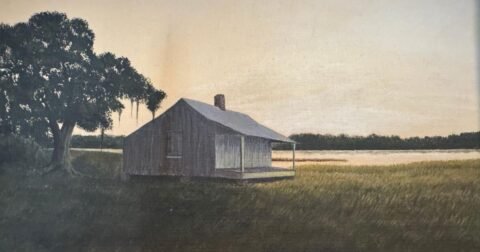It was only after his death that his family sorted through the vault containing his artwork, and uncovered a stash of bleak, violent drawings and paintings that seemed to express his inner rage and fear in a way that his cottage paintings never could: a shack in the middle of nowhere on a murky night; a nun pointing a gun at herself; giant monsters and distorted faces. Art for Everybody raises the questions of whether these pictures are more authentic than the ones the public knew about. Do they express how Kinkade really felt about his difficult upbringing and his frightening father? Would it have been healthier for him to explore the shadowy netherworlds in these pictures instead of shutting himself inside his stifling sylvan cottages, year after year? And were his critics right to say that his famous paintings were disturbing all along? “One of the things that was obvious early on,” says Yousef, “was that his fans had a two-dimensional view of him and his critics had another completely different two-dimensional view of him. I knew there was a three-dimensional person in there somewhere, and that’s what I wanted to try to find.”
In some ways, Kinkade was ahead of his time. First, he was a culture warrior before culture wars were being fought as fiercely as they are now. As someone who claimed that he was taking a stand for Christianity and patriotism and against the intellectual elite, he was staking out territory occupied by more and more in the US today. He was also ahead of his time as an artist with such a brazen commercial side. “Today we’re seeing all these artist collabs,” says Yousef. “There’s Yayoi Kusama who’s working with Louis Vuitton, and Tom Sachs is working with Nike, and Kehinde Wiley is doing a collab with American Express, whereas you see in the movie an MBNA bank card with a Thomas Kinkade painting on it. He was already doing it 20 or 30 years ago.”
Finally, by calling himself the Painter of Light, and by trading on his pious family-man persona, Kinkade turned himself into a kind of product. “Look at where we are today with social media, and everybody being a brand,” says Yousef. “He was really ahead of his time with that. But I think that one of the big questions of the film is, what are the costs of turning yourself into a brand?” In Kinkade’s case, the costs were unbearably high.
Art for Everybody is released on 28 March in the US.
—
If you liked this story, sign up for The Essential List newsletter – a handpicked selection of features, videos and can’t-miss news, delivered to your inbox twice a week.
For more Culture stories from the BBC, follow us on Facebook, X and Instagram.





